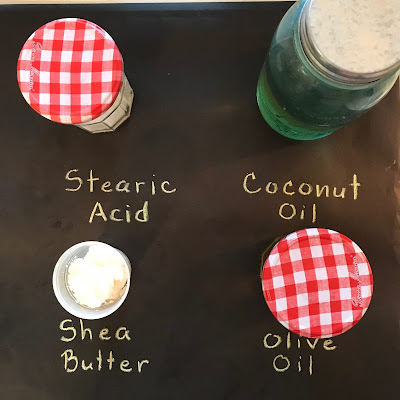If you have never paid much attention to soap I'm sure it has your attention now! While we're in a global hand washing frenzy and have a little extra time on our hands I thought I'd reshare the recipe I use to make my own soap. If you want to make the simplest version of soap possible you can start with melt and pour. For that read Goats Milk and Honey Soap.
If you want to make the most cost effective from scratch recipe like grandma used to make, well she was probably using tallow instead of these fancy fats, here's how to do that.
Often people see lye in the ingredients and ask if this is a harsh soap. Well, this is the only soap we use and my husband whose skin used to be so irritated by commercial soap loves it. I use it on my face. What makes commercial soap so harsh and drying isn't the lye which is necessary to make soap its all the detergents and other things added to it. As you'll see the fats and oils added to this recipe are very soothing.
Now let's get started!
But first...
SAFETY. SAFETY. SAFETY.
Lye is an extremely dangerous thing to work with. Especially when it is mixed with water. Always wear eye protection, rubber gloves, long sleeves, pants, and shoes for your protection. Do not make soap in the presence of children or pets!
Now that I've scared you silly, let's have some fun. You can use a lot of things for molds. Boxes, milk cartons, and silicone ice cube trays.
Some of my most popular soap is the little honeycomb ones. It's made in a silicone cake pan available on Amazon.
Ingredients:
distilled water
lye
coconut oil
olive oil
shea butter
stearic acid
Equipment:
Eye protection
Rubber gloves
Digital scale
stainless steel thermometer
large glass container
large stainless steel pot
non-reactive spoon or spatula
stick blender
mold
oils or scents
color
The Process:
Lye + water + oil/fat = soap
Lye (sodium hydroxide) is a salt. When the lye is combined with the oils/fats a the process that takes place is called saponification. Though lye is caustic in its original form once the saponification process is complete, no lye will be left in the finished product.
Measuring:
Because a chemical reaction is taking place is it important that you carefully measure all the ingredients. It's best not to use kitchen measuring cups or spoons for this but a digital scale.
The measurements I use for this recipe are:
16 oz. coconut oil
2 oz. olive oil
2 oz. shea butter
1 oz. stearic acid
3.4 oz. lye
7.1 oz. distilled water
Making the soap:
Carefully and slowly add the lye to the water (never the water to the lye!!!) and stir. Let cool.
Melt the oils and fats together in a glass container in the microwave. I add the shea butter last because it can get a little grainy if overheated.
Measure the temperature of the lye mixture and the oil mixture until they have cooled to 10 degrees of each other and are both below 130 degrees.
Pour the melted oils/fats into a large stainless steel pot. Carefully (are you wearing your goggles and gloves?) pour the lye mixture into the pot and stir. Next, insert the stick blender and begin blending your soap mixture. Gently, not vigorously. You don't want to introduce air bubbles. Continue blending until you achieve "trace."
Trace is when you can see a trail where you have dragged the blender through or when you drip some soap on the surface and it doesn't immediately disappear. Add colors and scents at this point and give a quick blend then pour into your mold. If you want to put anything in it that will remain solid now is the time to do that. I like to encrust my soap with herbs or flowers.
Cover with a towel and either let cool at room temperature of pop in the fridge. Overnight.
The next day pop it out of the mold and cut if necessary. Place in a cool dry place with good air circulation for 3-6 weeks. The process of making soap isn't finished until it has fully cured.
After that enjoy your luxurious homemade soap!








No comments:
Post a Comment
Let's put the social back in social media and continue the conversation on Facebook! Check out the Pen and Hive Page.